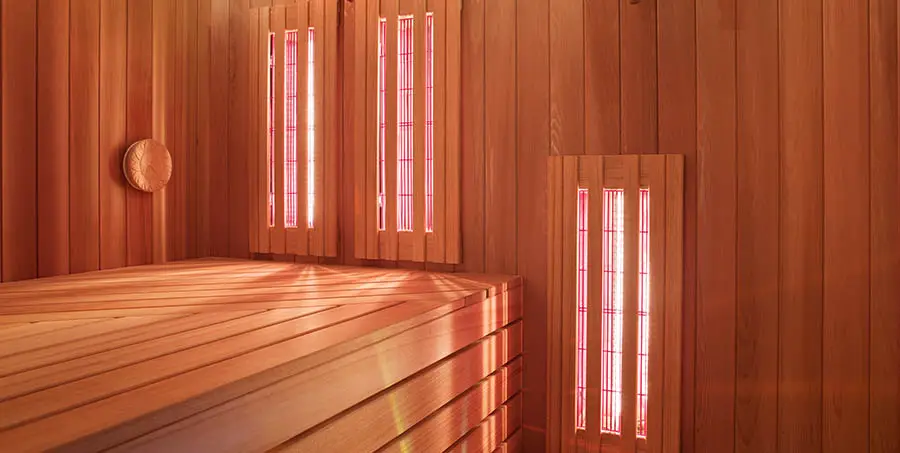Sweating it out in a sauna has been considered by many as beneficial for decades. While relaxing in a sauna is undoubtedly a good time, you may not be aware there are several very different types of saunas that use slightly different methods of heating your body. Besides traditional saunas, infrared or IR saunas are showing themselves as a new, great alternative that is not too-hot-to-handle.
Traditional saunas tend to have more health benefits than infrared saunas, including the delay of early onset of Alzheimer’s, the amelioration of stiff arteries, and more, compared to an infrared sauna that is most known for its benefits to respiratory systems.
Both traditional and infrared saunas are great methods to boost your physical and mental health. However, because the heating methods differ, you may find that you prefer one type over the other. To help you understand which sauna type is better for you, read on to learn how they work and the key differences between them.
Health Benefits of Traditional and Infrared Saunas
Saunas are touted as providing many health benefits to their users, and scientific studies have shown these benefits to be true. While your personal mileage may vary both infrared and traditional steam based saunas may lead to positive health effects such as:
- Increases resistance to respiratory diseases and pneumonia
- Delayed onset of Alzheimer’s disease and dementia
- Increased performance and recovery
- Relief from chronic pain and stiffness
- Reduced fatigue
- Increased blood flow and decreased chance of cardiovascular disease
As you can see in this list, traditional saunas and infrared saunas have many positive health effects, and you can get these from either method of sauna use. In regards to health effects, traditional saunas may have increased health benefits around your actual pulmonary system and breathing (e.g. they may make your sore throat feel a bit better!), because of all that moisture in the air. It’s worth understanding why this is the case, and the other differences between these sauna types, so you can pick the right technology for you.
How do Infrared and Traditional Saunas Work?
Infrared and traditional saunas have different heating principles. The mechanism, or type of “heat,” has different effects on your body, and it feels different too. Traditional saunas use a wood-burning stove or an electronics heater to heat the air and moisture in the sauna room. An infrared sauna uses infrared and sometimes far-infrared heating elements to warm your body directly.

How Traditional Saunas Work
Traditional saunas work by heating rocks and the air within the sauna room. The most “traditional” heating method of heat production is the use of a wood-burning stove to generate heat. Of course, this old-school heat source for traditional saunas has given way to electric heaters mostly. The method of heat production doesn’t matter so much here as what happens to that heat: typically it’s pumped into the space or used to heat some rocks or stones that hold that heat and allow it to build up in the space.
Those piles of hot rocks, they become a perfect surface to ladle a bit of water on, which boils instantly producing steam. This water vapor that is now literally boiling hot is in the air in the sauna, and it heats the air up incredibly quickly. This also means heating the room up is as simple as ladling on some more water! How does the heat get to your body in a traditional sauna, then? The hot air touches your skin, allowing that heat to flow into your body from the outside by first passing through your skin from the hot air.
How Infrared Saunas Work
Infrared saunas work by heating your body directly with the infrared wavelength of the electromagnetic spectrum. Don’t be alarmed by this technical language, it sounds like it could be dangerous, but we’re in the territory of technology that is well tested and safe for normal use. In fact, you experience the infrared wavelength every day from the sun. Your body absorbs the infrared wavelength of light, and it heats you up directly instead of the room and air around you.
Some infrared saunas go a step further and use far-infrared wavelengths. The far-infrared wavelength is slightly longer and penetrates your tissue slightly deeper than regular infrared, which heats you up more efficiently. So, while a traditional sauna heats the air, and then allows the air to heat you up by touching your skin, an infrared sauna actually beams heat directly into your body using these radiating waves of energy. No water, no steam.
A great example of this technology in use is the HigherDose V3 Sauna Blanket (link to their site), which uses infrared technology to shrink the equipment needed to get a sauna experience down to something you can fold up and tuck under the bed. And check out our related article on sauna blankets to learn more about this option in general.
What are the Key Differences Between Infrared and Traditional Saunas

Besides the way they operate, traditional saunas have additional differences. Since the heating methods are different, secondary changes may impact your choice between a traditional or infrared sauna. The fundamental deviations between the two are air temperature levels, humidity levels, energy costs, ease of use, and safety, all of which are described below.
Temperature of Infrared and Traditional Saunas
Traditional saunas traditionally operate between 155-230°F (68-110°C). The heating of sauna stones maintains this high temperature. The heat from the sauna stones transfers to the room’s air to provide a pleasantly even temperature. With a temperature this warm, you will be sweating right away.
Infrared saunas use IR or far-infrared radiation to heat the inside of your body. Since these saunas don’t impact the room’s air, IR saunas are relatively cool compared to their traditional counterparts clocking in at 120-140°F (49-60°C). However, the air temperature in IR saunas is almost irrelevant considering the IR is directly heating you and not the air. If a traditional sauna is uncomfortably hot for you, but you still want those health benefits, you can consider trying an infrared sauna that operates at a much lower temperature.
Humidity Levels of Infrared and Traditional Saunas
Traditional Finnish saunas are usually kept at a humidity level between 20 and 40%. Traditional saunas have heated saunas rocks traditionally located in a somewhat central spot in the room. The sauna occupants can use a bucket of water with a ladle to splash water on the stones to increase the humidity. Therefore, anyone within the sauna can adjust the humidity to their desired comfort level.
Infrared saunas usually don’t have variable humidity. Since infrared saunas are not designed to heat anything but occupants’ bodies, they do not heat the air nor rocks like traditional saunas. As such, there is no hot surface to splash water onto and create higher humidity levels. Therefore all types of infrared saunas are “dry” unless an extra steam generator is added.
Energy Costs for Infrared and Traditional Saunas
It is challenging to make a direct cost comparison between infrared and traditional saunas since the sizes, equipment used, and energy requirements are too variable. However, it is reasonable to say that, on average, traditional saunas use more energy than infrared saunas because they have to heat the entire space by bringing water to its boiling point.
Infrared saunas alone have to heat infrared radiation emitting panels that do not use a ton of power to operate and don’t need to heat up the entire room. Therefore, it is easy to say that an infrared sauna will use less energy and cost less to operate. However, how much less is an analysis that is too complex.
Ease of Use of Infrared and Traditional Saunas
Traditional and infrared saunas are both very easy to use. However, they require a warm-up period to get the sauna to ideal temperatures for user enjoyment. Traditional saunas typically take around 40 minutes to reach temperatures around 155°F (68°C), which is considered warm enough to use by many. If you desire higher temperatures, you have to wait much longer for the sauna to stabilize the higher heat levels.
Conversely, infrared saunas only take around 15 minutes to reach temperatures around 105°F (41°C), which many users consider an ideal temperature to jump in. However, a warm-up period for IR and FIR saunas is likely entirely unnecessary since they warm up your cells directly.
How do the Prices of Traditional and Infrared Saunas Compare?
Infrared saunas are almost always cheaper than traditional style saunas. Traditional sauna installers require specialized skills to ensure they are designed, insulated, ventilated and built correctly. The building materials of traditional saunas are specialized and cost more too.
Conversely, infrared saunas usually come flat packed as cookie-cutter units, ready for assembly. They require no specialized installation knowledge or skills to install. Thus, they cost much less than traditional saunas to purchase as a kit and install. If you’re building your sauna yourself, then constructing a steam sauna is probably cheaper than constructing an infrared one from scratch. So, the prices don’t really compare directly. It depends on if you’re purchasing a sauna or building on custom, and at that point prices are too unique from project to project to draw any universal conclusions.
Is a Traditional or Infrared Sauna Right for You?
Determining which sauna is right for you is challenging. To make the best choice, you need to consider what benefits and features are the most important. If you prefer lower air temperatures with no humidity, and a low install cost, then infrared saunas might be your top choice.
On the other hand, if you prefer the higher heat of traditional saunas and look forward to splashing water onto the hot rocks, you should opt for a traditional sauna. The health benefits for both types of saunas are many, with the traditional style sauna offering slightly more benefit from that moist air. But really, it’s the heating up of your body that leads to the health benefits, and both types of saunas get that job done.
